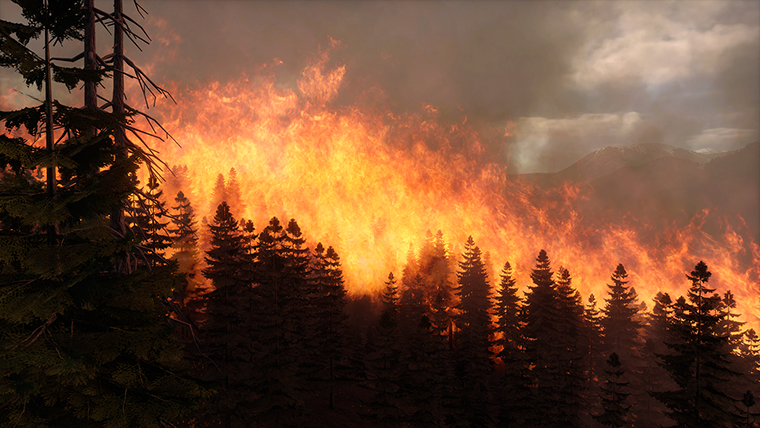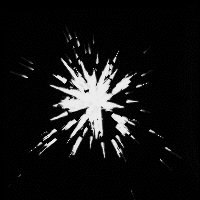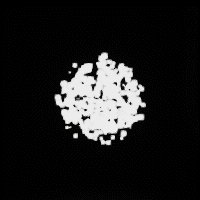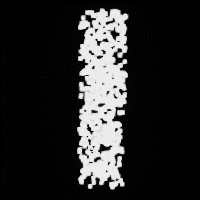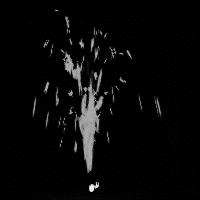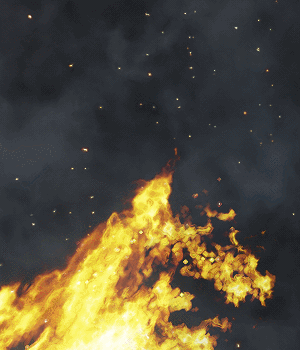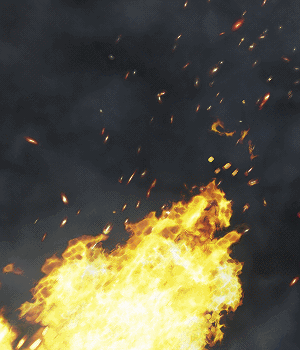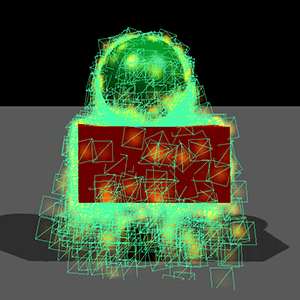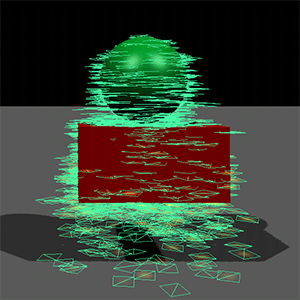粒子系统
A particle system is a really versatile technique that allows creating complex moving structures that produce dynamic and "fuzzy" effects. These structures are used for simulation of abstract effects of fire, smoke, explosions, electricity, fountains, rocket trails, flocking, magic, and many many more. All these effects are hard to reproduce using traditional rigid objects: particles are represented not by a set of primitive surface elements, but by point masses forming the volume of particle primitives. Another distinctive feature is that particles are not static — they may change not only their position, but also the form with the time.粒子系统是一种真正通用的技术,可以创建复杂的移动结构,从而产生动态和“模糊”效果。 这些结构用于模拟火焰、烟雾、爆炸、电力、喷泉、火箭轨迹、聚集、魔法等抽象效果。 所有这些效果都很难使用传统的刚性对象来重现:粒子不是由一组原始表面元素表示,而是由形成粒子图元体积的点质量表示。 另一个显着特征是粒子不是静态的——它们不仅可以改变其位置,还可以随着时间改变其形式。
A particle system consists of three main entities:一个粒子系统包括三个主要实体:
- Emitter — the source that emits particles according to the values set in the Emitter parameters.粒子发射器,源排放根据中设置的值 参数排放国。
- Particles themselves, which are emitted according to the predefined behavior after emission.根据预定义的粒子本身,发出行为后排放
- Additional physical effects applied to the particles that affect their behavior.额外的生理效应
See also另请参阅#
- The particles_base material to adjust the particles appearanceparticles_base材料调整粒子的外观
- The ObjectParticles class to manage particles via APIObjectParticles类来管理粒子通过API
- A set of samples located in the Art Samples suite. 一组样本位于Art Samples套件
Creating Particles创建粒子#
To create particles, perform the following steps:创建粒子,执行以下步骤:
- On the Menu bar, click Create -> Particle System -> Particles.
在菜单栏,点击Create -> Particle System -> Particles。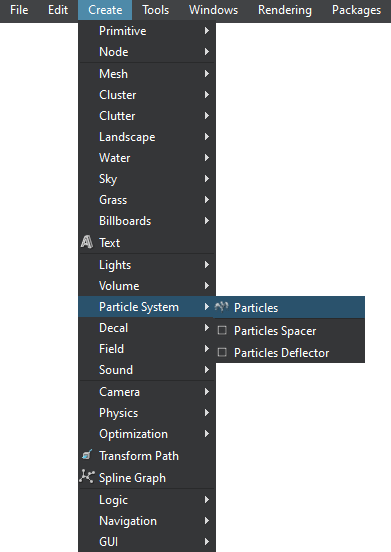

- Place the Particles object somewhere in the world.粒子对象在世界上的地位。
- Specify the particles parameters.指定粒子参数。
Emitter Parameters排放参数#
The particles emitter's behaviour is set via the Emitter parameters.粒子发射器的行为通过发射器设置参数。
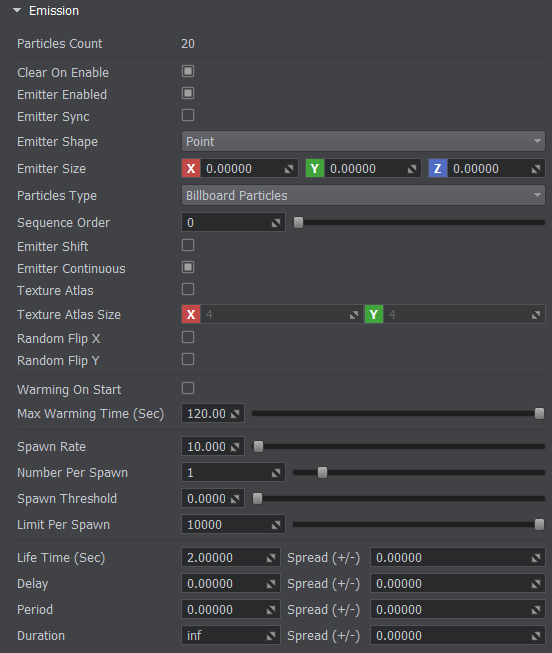
| Clear On Enable | Enables re-initialization of the particle system each time it is enabled. When this option is disabled, turning on the particle system restores the state it had before it was turned off.使初始化粒子系统的每次启用。禁用此选项时,将粒子系统恢复之前的状态。 |
|---|---|
| Emitter Enabled | Enables the emitter.使发射器。 |
| Emitter Sync | Enables synchronization of the child particle system with the parent one, even if the child particle system has the Emitter Enabled option disabled.使孩子与父母一个粒子系统的同步,即使孩子粒子系统Emitter Enabled选项禁用。 |
| Emitter Shape |
The shape of the volume within which the particles are generated:的形状体积内生成的粒子: |
| Emitter Size | The size of the particles source. The number of fields (whether it is radius or boundary dimensions) depend on the chosen shape.粒子的大小。字段的数量(无论是半径或边界尺寸)取决于选择 形状。 |
| Particles Type |
|
| Sequence Order |
The order of rendering for particle systems, especially when creating a complex effects like shots (with muzzle flash, smoke and the shot itself, each rendered with different particle systems). This parameter is very much the same as Rendering Order option in the Materials Settings. But it allows setting a rendering sequence inside of the particle system hierarchy, to avoid such situations when the smoke from a distant shot is rendered atop of the fire of the foreground shot.粒子系统的渲染顺序,尤其是在创建像射击这样的复杂效果时(带有枪口闪光、烟雾和射击本身,每个效果都使用不同的粒子系统渲染)。 此参数与材质设置中的 渲染顺序 选项非常相似。 但它允许在粒子系统层次结构内部设置渲染序列,以避免将远处镜头的烟雾渲染在前景镜头的火焰之上时出现这种情况。
|
| Emitter Shift | Enabling this checkbox makes the emitter generate particles only when the Particle System is moving.启用这个复选框使发射器产生粒子只有当粒子系统是移动。 |
| Emitter Continuous | Enables continuous particles that follow the shift of the emitter.使连续粒子发射器的转变。 |
| Texture Atlas |
Enabling this feature makes the following: a random image from the albedo texture is picked up for every particle. 启用这个特性使得如下:反照率的随机图像纹理 注意
For using this option, Animation of the texture should be disabled.使用这个选项, 动画纹理的应该是禁用的。 |
| Texture Atlas Size | The size of the texture atlas. 大小的纹理地图集。 |
| Random Flip X |
Flipping of random emitted particles horizontally (along the X axis).翻转随机发射粒子的水平(沿着X轴)。
|
| Random Flip Y |
Flipping of random emitted particles vertically (along the Y axis).垂直翻转的随机发射粒子(沿着Y轴)。
|
| Warming On Start | Toggles on and off the particle system initialization with the illusion of prior activity. The particle system evolves with time, so after encountering it in the virtual world, the system only starts to be generated, particle by particle, until the whole system gains the intended look. When the character comes out on a glade, we will see a fire gradually burn up. Warm start for the particles enables rendering the full-grown particle system straight away. The technical implementation of warm start is the following: when the particle system is initialized on the encounter, its life is computed starting from the generation of the first particle to its disappearance. After that, the particle system is considered evolved and is rendered in this state. The calculations are taken at a fixed frame rate of 25 fps, which is the minimum required for the correct simulation of particle systems (see also information about correlation between framerates). Warm start can be enabled without any detrimental effect for any particles systems, except for huge ones.使用先前活动的幻象打开和关闭粒子系统初始化。 粒子系统会随着时间的推移而进化,所以在虚拟世界中遇到它之后,系统才会开始逐个粒子地生成,直到整个系统获得预期的外观。 当角色出现在林间空地时,我们会看到火逐渐燃烧。 粒子的热启动可以立即渲染成熟的粒子系统。 热启动的技术实现如下:当粒子系统在相遇时初始化时,其寿命是从第一个粒子的产生到其消失计算的。 之后,粒子系统被视为进化并以这种状态渲染。 计算以 25 fps 的固定帧速率进行,这是正确模拟粒子系统所需的最低速率(另请参阅有关帧速率之间的相关性)。 启用热启动不会对任何粒子系统(大型粒子系统除外)产生任何不利影响。 |
| Max Warming Time (Sec) | Maximum time of the particle system warmup.粒子系统的最大时间热身。 |
| Spawn Rate | Number of spawn actions per second. The value defines how many times a certain number of particles will be spawned in one second. For example, the value set to 5 equals to 5 spawn actions per second. 0 results in no particles at all. 每秒的产卵行为。 的值定义了多少次 特定数量的粒子将在一秒钟了强。例如,值设置为 = 5每秒产生行动。 0 导致任何粒子。 |
| Number Per Spawn | Number of particles to be spawned simultaneously each time according to the Spawn Rate.粒子数,同时催生了每次根据Spawn Rate。 |
| Spawn Threshold |
Threshold of the number of particles depending on the velocity of the parent particles. 注意
|
| Limit Per Spawn | The total maximum number of particles emitted per spawn. This parameter specifies the number of particles that can simultaneously exist in the world. In other words, the number of particles existing in the world cannot exceed the limit value. For example, if the Number per Spawn value is 10, and the Limit Per Spawn value is 5, 5 particles will be emitted. And no particles will be spawned until the previous ones exist.每次生成的最大粒子总数。 该参数指定世界上可以同时存在的粒子数量。 也就是说,世界上存在的粒子数量不能超过极限值。 例如,如果每个生成的数量值为10,并且每个生成的限制 值为 5,将发射 5 个粒子。 在先前的粒子存在之前,不会生成任何粒子。 |
| Life Time (Sec) | Duration of the particles existence after emission in seconds. This parameter also has the Spread value that creates the variety of the Life Time value, in seconds.粒子发射后存在的时间,以秒为单位。该参数还有一个Spread值,用于创建Life Time值的变化,以秒为单位。 |
| Delay | This option defines the time to pass between the parent system initialization and initialization of the child node. If any delay is set, the parent system starts emitting particles, and after the delay, the generation of child particles is activated. If a particle system doesn't have children, the delay defines the time after which the particles are emitted. This parameter also has the Spread value that creates the variety of delay of particle initialization, in seconds. T该选项定义了父系统初始化和子节点初始化之间传递的时间。 如果设置了任何延迟,则父系统开始发射粒子,延迟后,激活子粒子的生成。 如果粒子系统没有子级,则延迟定义粒子发射后的时间。 此参数还具有 Spread 值,该值创建粒子初始化的延迟时间(以秒为单位)。 |
| Period | Duration of a pause between generation cycles, in seconds.一代之间的停顿时间周期,以秒计。
This parameter also has the Spread value that creates the variety of the Period value, in seconds.这个参数也有Spread价值创造的各种周期值,以秒计。 |
| Duration |
Duration of generation cycle, within which emission occurs, in seconds.代时间周期,在发射时,以秒计。
This parameter also has the Spread value that creates the variety of the Duration value, in seconds.这个参数也有Spread价值,这个值创造了多种的时间价值,以秒计。 |
| Spread (+/-) | Spread option introduces additional modulation of the corresponding parameter. It represents the range of values that can be randomly added to or subtracted from the specified parameter value.分布选项引入了额外的相应的调制参数。它代表值的范围,可以随意增加或减少从指定的参数值。 |
Behavior After Emission行为后排放#
This set of parameters defines how the particles behave after they are emitted:这组参数定义了粒子发射后:
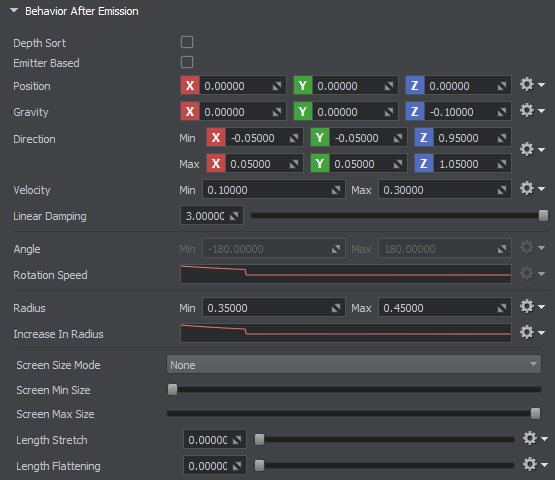
Value Setting Options值设置选项#
Most parameters in this section have multiple options for setting a value:大多数参数在这一节中有多个选项,设置一个值:

- Const — the value is precise and unchanged over time.Const 值是精确的和不变。
- Between Const — an interval is set, from which a random value is selected for each instance.Between Const 间隔设置,选择一个随机值为每个实例。
- Curve 参数值的变化随着时间的推移,根据中定义的曲线曲线编辑器
-
Curve — the parameter value changes over time based on the curve defined in Curve Editor.Curve 参数值的变化随着时间的推移,根据中定义的曲线曲线编辑器
注意In case of small values (close to 0), the curves may lose accuracy if the Max Value value significantly exceeds the actual maximum value of the curve. To avoid this, Max Value should be set as close to the actual maximum as possible.在数值较小(接近0)的情况下,如果 Max Value 值明显超过曲线的实际最大值,曲线可能会失去精度。为了避免这种情况,Max Value 应该设置得尽可能接近实际最大值。 - Between Curve — there are two curves set in Curve Editor that define the limits, and a random value is taken at every moment of time within these limits. The parameter value changes over time based on this randomly generated set of values.Between Curve 有两条曲线设定曲线编辑器
To select a desired value type, use the gear button.
选择所需的值类型,使用装置按钮。
| Depth Sort | Depth sorting is required, if particles use alpha blending (except for the additive one). If not enabled, then based on the depth buffer data, opaque objects positioned farther can be wrongly rendered in front of transparent particles. With depth sorting, geometry is rendered in the order from back to front, which rules out visual artifacts.深度排序是必需的,如果粒子使用α混合(除了添加剂)。如果未启用,那么基于深度缓冲数据,不透明的物体定位远可以错误地呈现在面前的透明粒子。随深度排序、几何呈现的顺序从后往前 ,这排除了视觉工件。 | ||||
|---|---|---|---|---|---|
| Emitter Based | Enabling this option makes particles move along with the emitter.启用这个选项使粒子运动以及排放国。 | ||||
| Position | Particle position coordinates relative to the emitter along X, Y and Z axes.粒子的位置坐标相对于发射极沿着X , Y Z 和 轴。 | ||||
| Gravity |
Gravity force affecting particles along the X, Y and Z axes.重力影响粒子沿着X , Y Z 和 轴。
Most parameters in this section have multiple options for setting a value:粒子系统节点的旋转不影响重力向量。 |
||||
| Direction | Direction in which all emitted particles move forming a flow, specified along the X, Y and Z axes.方向所有发射粒子运动形成一个流,沿着指定 X , Y Z 和 轴。 | ||||
| Velocity | The speed of particles movement in the set direction, in units per second. To grant the natural-looking flow, the final velocity of each separate particle can differ, if the range of values is set.粒子运动的速度方向设置 | ||||
| Linear Damping | The decrease in particles linear velocity over time. This parameter is used to simulate effect of friction of the medium for particles.粒子线 速度随时间的减少。这个参数是用来模拟摩擦介质的粒子的影响。 | ||||
| Angle | Angle of particles orientation in space, in degrees. |
||||
| Rotation Speed | Angular velocity of particles, in degrees per second.粒子的角速度度每秒。
|
||||
| Radius | Radius (half-size) of the particle.半径(半尺寸)的粒子。 | ||||
| Increase In Radius | Increment of the size of a particle, in units per second.增量的大小的粒子,在单位每秒。
|
||||
| Screen Size Mode |
Screen size mode to be used for particles. This mode defines whether the maximum and minimum sizes of emitted particles should be limited relative to screen size or not (e.g., to avoid cases when snowflakes or raindrops obscure the view if they are too close to the camera or when they become invisible as the distance to the camera increases). Three modes are available:用于粒子的屏幕尺寸模式。 此模式定义发射粒子的最大和最小尺寸是否应相对于屏幕尺寸进行限制(例如,为了避免 如果雪花或雨滴离相机太近,或者随着与相机的距离增加而变得不可见,就会遮挡视图)。 三种模式可供选择:
|
||||
| Screen Min Size |
Minimum screen size to be set for particles limiting the minimum fraction of the screen a single particle can occupy:最低屏幕上粒子的大小,为限制单个粒子可以占领最低的部分:
|
||||
| Screen Max Size |
Maximum screen size to be set for particles limiting the maximum fraction of the screen a single particle can occupy:最大屏幕上粒子的大小,为限制单个粒子可以占领最大的部分:
|
||||
| Length Stretch | Stretching of a particle billboard, available for the Length Particles. With the value of 0, the length particle is simply a square billboard. Increasing the value stretches particles in the direction of their movement. The result is calculated by multiplying the stretch value by the particle velocity value. So, the higher the velocity is, the more stretched the particles are in the direction of their movement, while the other side remains of the same width.粒子广告牌的拉伸,可用于Length Particles。 当值为0时,长度粒子只是一个方形的广告牌。 增加该值会沿粒子的运动方向拉伸粒子。 结果是通过将拉伸值乘以粒子速度值来计算的。 因此,速度越高,粒子在其运动方向上拉伸得越多,而另一侧保持相同的宽度。
|
||||
| Length Flattening | Makes the Length Particles not camera-oriented as usual billboard particles, but more perpendicular to the Z axis. With the value of 0, the particles are not flattened. With the maximum value of 1, the particles will be flat (perpendicular to the Z axis) when they are emitted.使 长度粒子 不像通常的广告牌粒子那样面向相机,而是更垂直于 Z 轴。 值为0时,粒子不会被压平。 最大值为1时,粒子在发射时将是平坦的(垂直于Z轴)。
|
Interaction交互#
Interaction of the particles is limited to the application of forces and collisions with external objects. There are two methods to detect the collision with external objects: by using the Physics Intersection parameter or the Collision parameter.粒子的相互作用仅限于施加力以及与外部物体的碰撞。 有两种方法可以检测与外部对象的碰撞:使用 Physics Intersection 参数或 碰撞参数。

| Physical Mask | For a more selective interaction of the particles systems with physical nodes, the physical bit mask is used. This bit mask is set for both the particles system and the force. These masks should have at least one bit matching, otherwise there would be no interaction. The other bits of the mask can match masks of other forces, thus providing perfect control over the scene integration.为了使粒子系统与物理节点进行更具选择性的交互,使用physical位掩码 。 该位掩码是为粒子系统和力设置的。 这些掩码应该至少有一位匹配,否则不会有交互。 遮罩的其他部分可以匹配其他力的遮罩,从而提供对场景集成的完美控制。 |
|---|---|
| Particles Field Mask | Bit mask for interaction with Particles Field nodes (Deflectors and Spacers). Emitted particles will be affected by a Particles Field only if their masks match (one bit at least).位元遮罩与Particles Field交互节点(Deflectors和Spacers)。发射粒子会受到一个Particles Field只有它们的位掩码匹配(至少一位)。 |
| Physical Mass |
To participate in the scene dynamics, particles should have a certain mass in kilograms. This value defines the intensity of the impact of the physical node on the particles flow.参与现场动态,在公斤粒子应该有一定的质量。这个值定义的影响强度 物理节点上的粒子流。 注意
The Physical Mass parameter doesn't affect other calculations.Physical Mass参数不会影响其他计算。
|
| Restitution |
Strength of particles bouncing off an obstacle. This option is very convenient for simulation of some water effects that include splashes. The strength the bouncing effect depends on both the restitution parameter of particles and the value of the restitution surface parameter set for the colliding object (Properties -> Parameters -> Restitution), or the restitution value of a Particles Deflector.粒子反射障碍的力量。这个选项非常方便模拟一些水的影响,包括溅。力量反弹的效果取决于粒子的返还参数和的值restitution表面碰撞对象的参数集(Properties -> Parameters -> Restitution)或restitution Particles Deflector的价值。
|
| Roughness |
Roughness of the surface of an obstacle the particle collides with. It determines whether the particles scatter in different directions or react as a uniformly directed flow.粗糙表面的粒子碰撞的一个障碍。它决定了粒子分散在不同的方向或反应均匀定向流动。
|
| Collision |
Enables collision detection with the whole shape of a particle. Collisions are detected for matching collision bit masks.碰撞检测到匹配collision位掩码。 |
| Physics Intersection |
Enables detection of physics intersections with particles. Physics intersections can be used, for example, to detect collisions of spawned particles with physical shapes and bodies or static collider surfaces to ensure proper interaction, or as a quick way to detect collisions for raycast-wheels of a simulated ground vehicle, or to check if a destructible object or a player was hit by a projectile.能够检测与粒子的物理交叉点。 例如,物理相交可用于检测生成的粒子与物理形状和物体或静态对撞机表面的碰撞,以确保正确的交互,或者作为检测模拟地面车辆的光线投射轮碰撞的快速方法,或者检查 如果可破坏的物体或玩家被射弹击中。 Physics intersections are detected for matching Physics Intersection bit masks.物理交叉检测匹配Physics Intersection位掩码。 |
| Destroy In Collision/Intersection | Toggles on and off culling of particles that have already undergone either collision or intersection.切换开关剔除的粒子,已经经历了碰撞或十字路口。 |
Render To Texture纹理渲染#
Particles can be rendered into a procedural texture to be used by an Orthographic Decal or a Field Height. This feature can be used, for example, to create ship wake effects or oil splashes.粒子可以渲染为程序纹理,以供 正交贴花 或 字段高度。 例如,此功能可用于创建船舶尾流效果或油溅效果。
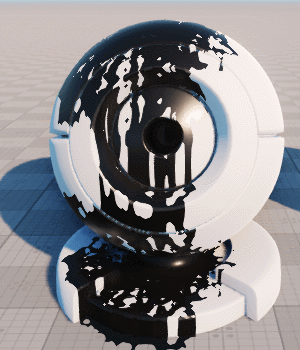
The following settings are available:以下设置:

| Rendering | Enables rendering of particles to a procedural texture.使粒子渲染程序结构。 |
|---|---|
| Positioning |
Defines positioning mode to be used for child nodes (decal or field) using the procedural texture, to which the particle system is rendered. The following values are available:定义了定位模式用于子节点使用过程纹理(贴花或字段),粒子系统的呈现。可用以下值:
注意
Takes effect only when Procedural Parenting is set to Children.仅当Procedural Parenting设置为Children时生效。 |
| Parenting |
Defines relationship between the particle system and a Decal / Field node, that uses the procedural texture into which the particle system is rendered:定义了粒子系统和Decal / Field节点之间的关系,该节点使用粒子系统渲染到的过程纹理:
|
| Resolution |
Specifies resolution of the procedural texture into which particles are rendered.指定分辨率的程序结构,粒子渲染。
|
Additional Physical Effects额外的生理效应#
More intricate changes in further movement of the particles may be performed by applying the additional physical effects. They have influence on the particles flow in the desired direction or on the contrary deflect it. The effects can be of three general types:更复杂的变化进一步运动粒子可能通过应用执行额外的生理效应。它们影响了粒子流的方向或相反的转移。三个一般类型的影响可以:
There is no limitation to the number of additional physical effects applied to one particle system and they can freely overlap, enabling to constitute complex trajectories easily and fast.没有限制数量的额外的生理效应应用于一个粒子系统,它们可以自由地重叠,使构成复杂轨迹容易和快速。
Forces力#
You can apply a physical force to particles inside a sphere-shaped volume in order to affect their movement and behavior. For that, simply add a Physical Force node, adjust necessary settings and set up Physical Masks to selectively enable interaction.您可以对球形体积内的粒子施加物理力,以影响它们的运动和行为。为此,只需添加Physical Force节点,调整必要的设置并设置Physical Mask以选择性地启用交互。
Noises噪音#
You can apply physical noise adding a distribution flow based on a volumetric noise texture inside a cuboid-shaped volume. For that, simply add a Physical Noise node, adjust necessary settings and set up Physical Masks to selectively enable interaction.您可以应用物理噪声,并在长方体体积内添加基于体积噪声纹理的分布流。为此,只需添加Physical Noise节点,调整必要的设置并设置 Physical Mask 以选择性地启用交互。
Deflectors导向板#
Sometimes it is necessary to put an obstacle for particles to make them change their trajectory by bouncing off or sliding along a certain surface. For this purpose you can use a Particles Deflector node, a surface field that has no visual representation, but physically interacts with Particle Systems leaving other objects unaffected. You can control interaction between the particles and deflectors via the Particles Field mask: a deflector will interact with particles generated by a Particle System if they both have matching Particles Field masks (one bit at least).有时需要为粒子设置障碍物,使它们通过弹跳或沿着某个表面滑动来改变轨迹。 为此,您可以使用 Particles Deflector 节点,这是一个没有视觉表示的表面场,但与粒子系统进行物理交互,而其他对象不受影响。 您可以通过Particles Field蒙版控制粒子和偏转器之间的交互:如果偏转器与粒子系统生成的粒子都具有匹配的Particles Field蒙版(至少一个比特)。
For more information on Particles Deflector please refer to this article.关于Particles Deflector的更多信息,请参阅本文。
Particles Node Hierarchy粒子节点层次结构#
To create complex effects, it is necessary that all particles systems are synchronized in time. Setting a particle system as a parent node results in the following:创建复杂的影响,有必要对所有粒子系统的同步。设置一个粒子系统作为一个家长节点下面的结果:
- All particles systems that are child nodes are synchronized relative to their parent particle systems. If the children have children of their own, they still are synchronized with the main parent system, which is the highest in the hierarchy.所有作为子节点的粒子系统都相对于其父粒子系统同步。 如果子系统有自己的子系统,它们仍然与层次结构中最高的主父系统同步。
- When creating a new child particle system, it should be synchronized with the parent one by disabling and again enabling the parent emitter (Node tab -> Enabled box). At this moment, each of the child systems is initialized with its Emitter parameters (such as generation duration, period of generation pause, and delay of initialization).创建新的子粒子系统时,应通过禁用然后再次启用父发射器(Node 选项卡 → Enabled框)。 此时,每个子系统都用其发射器参数进行初始化(例如生成持续时间、生成暂停的时期和初始化的延迟)。
- Disabling or enabling the parent emitter (Node tab -> Enabled box) affects all child particle systems: they synchronously stop or start emitting particles (emitted particles still live out their time).禁用或启用父发射器(Node选项卡 → Enabled框)会影响所有子发射器 粒子系统:它们同步停止或开始发射粒子(发射的粒子仍然有效)。
- Disabling or enabling the parent node (Node tab -> Enabled box) also affects all children: all particle systems in the hierarchy are turned off and on — and preserve the same state as was at the moment of their disabling.禁用或启用父节点(Node选项卡 → Enabled框)也会影响所有子节点:层次结构中的所有粒子系统都被关闭和打开,并保持与禁用时相同的状态。
Synchronizing Several Particle Systems同步多个粒子系统#
To synchronize several particle systems, for example, to create a shot effect (with three particle systems: muzzle flash, smoke and the bullet), you can do the following:同步几个粒子系统,例如,创建一个拍摄效果(有三个粒子系统:枪口flash,烟雾和子弹),你可以做以下几点:
-
Create the parent particle system that will be used as a dummy one, purely for synchronization purposes (you can even disable its surface). Its Duration time interval should cover all duration intervals and delay intervals (if any) of the children particle systems. Other parameters (Spawn Rate, etc.) do not matter.创建父粒子系统,将被用作一个假,纯粹用于同步(你甚至可以禁用它的表面)。Duration设置中的时间间隔应该涵盖子粒子系统的所有持续间隔和延迟间隔(如果有的话)。其他参数(Spawn Rate 等)并不重要。

-
Add the child particle systems. They can have any Duration time required (but it should be smaller than the one of the parent). For example, to synchronize all child particle systems at once and spawn only one particle, you can set the following:添加子粒子系统。它们可以有时间所需的时间(但应该小于父之一)。例如,同步所有子粒子系统,只产生一个粒子,可以设置如下:
- Duration = 0
- Limit Per Spawn = 1
- Spawn Rate = inf/100000
Optimizing Simulation优化仿真#
Updating each frame a huge number of objects located far away from the camera that are hardly distinguishable or observed as a mass is a waste of resources.更新每一帧一个巨大数量的对象位于远离摄像机很难区分或观察作为一个质量是一种资源浪费。
To improve performance and avoid the excessive load, particle systems simulation can be updated with a reduced framerate. When a particle system is out of the area specified by the Update Distance Limit, particles stop to be updated and freeze statically.为了提高性能和避免过度的负载,粒子系统模拟可以使用减少的帧数集进行更新。当粒子系统超出Update Distance Limit指定的区域时,粒子停止更新并静态冻结。
The set of frame rates given below enables you to specify how often the particles simulation should be updated when the particle system is visible, when only its shadow is visible, and when it is not visible at all.下面给出的组帧速率使您能够指定粒子模拟频率应该更新粒子系统是可见的,当仅能看到它的影子,或者当它是不可见的。

This feature is enabled with default settings ensuring optimum performance and can be adjusted per-object in the UnigineEditor or via API at run time.启用这个特性与默认设置确保最佳性能,可以调整逐对象式UnigineEditor或在运行时通过API。
If your project, for example, contains an invisible particle system (e.g., using the Viewport mask) and some logic attached to its update (e.g. spawning some visible particles on collision with objects) this logic won't work, as the particle system might be updated with a reduced rate or might not be updated at all. To enable updating such objects regardless of their visibility you can set the Update Distance Limit and corresponding update rate values for it to infinity.例如,如果您的项目包含不可见的粒子系统(例如,使用 Viewport mask)以及附加到其的一些逻辑 更新(例如,在与对象碰撞时生成一些可见粒子)此逻辑将不起作用,因为粒子系统可能会以降低的速率更新,或者可能根本不更新。 要启用更新此类对象(无论其可见性如何),您可以将Update Distance Limit及其相应的更新速率值设置为infinity。
Mesh-Based Particles基于网格粒子#
It is possible to create mesh-based particle systems. For that, Mesh Cluster should be added as a child node of the particle system (ObjectParticles). After that, meshes are automatically spawned by the emitter.可以创建基于网格粒子系统。为此,Mesh Cluster应该添加一个子节点的粒子系统(ObjectParticles)。在那之后,网格是由发射器自动产生的。

本页面上的信息适用于 UNIGINE 2.19 SDK.

